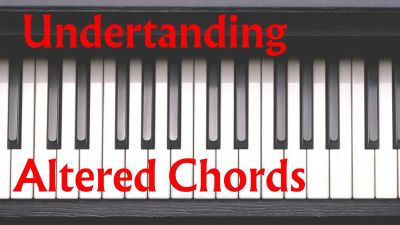If you struggle with altered chords, I want to simplify the construction of them in a way that makes them easy to understand.
An Altered chord is defined as having one or more tones of the diatonic key that have been raised or lowered a half step. These tones are referred to as chromatic, meaning they are non diatonic or not belonging to the key.
If I had to point out one element in music that adds interest to the harmony of a piece of music, it would be tension. Tension can come in the form of single chromatic tones or chords. If you’re familiar with accidentals, you know that these notes pop up in a song and aren’t in the key.
In this article, I want to share with you an easy way to understand altered chords. Altered chords contain tones that are not in the key. This is what creates the tension in harmony that I’m referring to.
There are a few things to understand about altered chords:
- They are constructed from extended chords
- They can be Major or minor
- They are often used as passing chords or substitution chords
- They are used more in jazz or jazz influenced music
- They are often used sporadically in chord progressions
- They are almost always resolved by a consonant chord that releases the tension
If you understand extended chords, it’s not much of a leap to altered chords. To make it short and sweet, extended chords are Major or minor triads that have extended tones in them.
For example you can have a C Major triad, it may contain the 7th, 9th, 13th etc.

It’s from this type of chord that altered tones will give it some flavor that it wouldn’t have otherwise. But the essential aspect of altered tones is to know that there are two notes in the key that altered tones are centered around.
These two notes are the 2nd and the 5th.

The altered tones can be a half step above or below each one of these notes and can be in any combination.

It’s also important to note that even though these two tones are known as the 2nd and the 5th, they are referred to by different numbers in different contexts.
The 2nd is referred to as the 9th when it’s added to a dominant 7th chord. This in turn changes the reference to either tone a half step above or below as a sharp 9 or flat 9 respectively.



The 5th can be raised or lowered to create altered tones. The altered tones above or below it are referred to as a sharp 5 or flat 5.


These altered tones can also be referred to as different numbers because they can also be in the context of notes that are a whole step above and below the 5th.
This would be the 11th tone and the 13th tone.

The 11th is a whole step below the 5th. Raising the 11th produces the sharp 11th altered tone. The purpose of this reference would be if you’re already playing the 5th in the chord. But it can also be referred to as the sharp 11th even if the 5th is omitted.

C7 sharp 11th without the 5th

The 13th is a whole step above the 5th. Lowering the 13th produces the flat 13th altered tone. The purpose of this reference would be if you’re already playing the 5th in the chord. But it can also be referred to as the flat 13 even if the 5th is omitted.

C7 flat 13th without the 5th

Here’s a recap of the construction and use of altered tones:
- Altered tones are always a half step above and below the 2nd and 5th tones
- In different contexts, these altered tones can be referred to by different numbers
- They’re incorporated into extended chords to give them additional color
- Altered chords create tension that often resolve into consonant chords
If you’re new to creating altered chords, it helps to break down and understand the simple tones they’re derived from. Try substituting some of your extended chords by altering them. Now you know how simple it can be to understand altered chords.
Until next time, Go Play.
Greg Lee
Latest posts by Greg Lee (see all)
- What is a minor/Major 7 Chord? - October 26, 2023
- 7 Chord Substitutions that Professionals Use - October 19, 2023
- 5 Simple Chord Tricks to Sound Amazing - October 5, 2023




